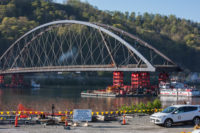...while held by cables from across the stadium. By then, the towers had done their job and the jacking cable had lost its tension.
 |
| ICON Roof arch, which spans 315 m, is intended as the worlds greatest sports landmark. (Image courtesy of Wembley National Stadium Ltd.) |
Still guyed, the arch was due to be lowered to its final 112° orientation. It will remain held for several months until remaining roof structures are installed to provide permanent cable support. Structures include upwardly splaying, 30-cm-dia tubes rising up to 7 m around the bowls rim. They will prop a triangular section truss to support the roof and act as a compression ring for its stressed cables. The arch will then be stabilized by balanced cable forces from the roof and back stays.
Planned since the mid-1990s as a national multisport stadium, the project almost died five years ago as the government interest became cooler and Wembley National Stadium struggled to raise financing. Then, with financing in place, the decision to demolish the former stadiums twin white towers, which had been the emblem of English soccer since the 1920s, drew criticism.
Multiplex, which helped raise financing, started its $830-million design-build contract in September 2002. Its owner-selected design team also includes London-based HOK+LOBB Sports Architecture, and Mott MacDonalds Australian affiliate Connell Mott MacDonald. Claiming good progress, Multiplexs project director Ashley Muldoon hopes to hand over by the June 2006 deadline, despite the late arch lift.
|


Post a comment to this article
Report Abusive Comment